英语学术写作
英文学术报告作文
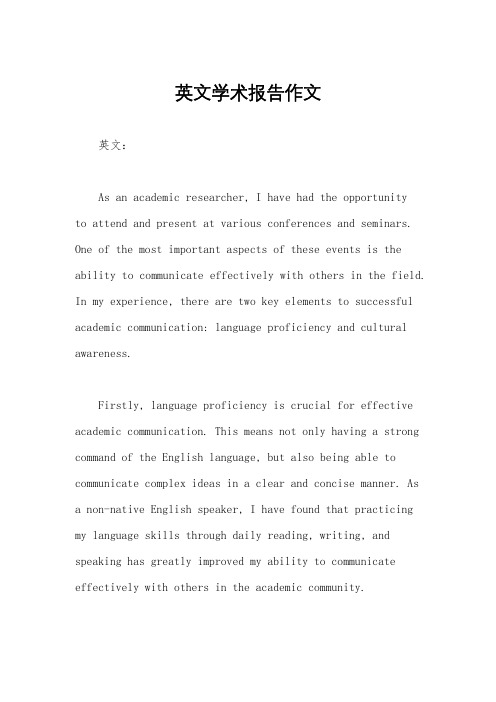
英文学术报告作文英文:As an academic researcher, I have had the opportunityto attend and present at various conferences and seminars. One of the most important aspects of these events is the ability to communicate effectively with others in the field. In my experience, there are two key elements to successful academic communication: language proficiency and cultural awareness.Firstly, language proficiency is crucial for effective academic communication. This means not only having a strong command of the English language, but also being able to communicate complex ideas in a clear and concise manner. As a non-native English speaker, I have found that practicing my language skills through daily reading, writing, and speaking has greatly improved my ability to communicate effectively with others in the academic community.Secondly, cultural awareness is also important in academic communication. Understanding the cultural normsand expectations of others in the field can help to avoid misunderstandings and promote positive interactions. For example, in some cultures, it may be considered rude to interrupt someone during a presentation, while in others it may be seen as a sign of engagement. Being aware of these cultural differences can help to ensure that communicationis respectful and effective.In summary, language proficiency and cultural awareness are two key elements to successful academic communication. By continually improving our language skills and beingaware of cultural differences, we can promote positive interactions and advance our research in the field.中文:作为一名学术研究人员,我有机会参加和发表各种会议和研讨会。
英语学术写作的特点
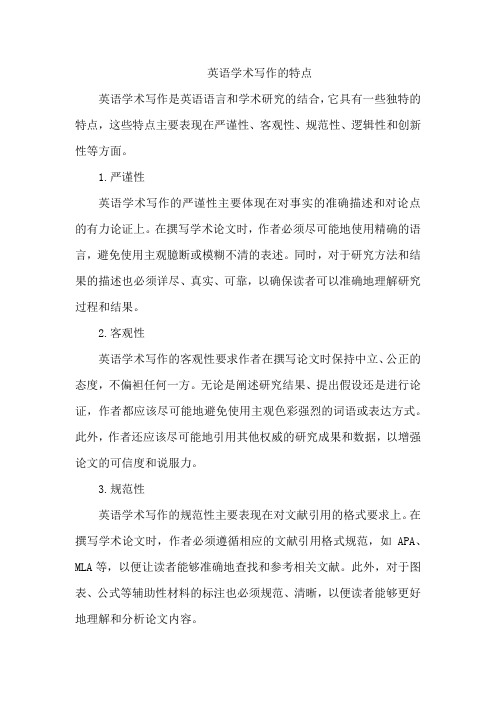
英语学术写作的特点英语学术写作是英语语言和学术研究的结合,它具有一些独特的特点,这些特点主要表现在严谨性、客观性、规范性、逻辑性和创新性等方面。
1.严谨性英语学术写作的严谨性主要体现在对事实的准确描述和对论点的有力论证上。
在撰写学术论文时,作者必须尽可能地使用精确的语言,避免使用主观臆断或模糊不清的表述。
同时,对于研究方法和结果的描述也必须详尽、真实、可靠,以确保读者可以准确地理解研究过程和结果。
2.客观性英语学术写作的客观性要求作者在撰写论文时保持中立、公正的态度,不偏袒任何一方。
无论是阐述研究结果、提出假设还是进行论证,作者都应该尽可能地避免使用主观色彩强烈的词语或表达方式。
此外,作者还应该尽可能地引用其他权威的研究成果和数据,以增强论文的可信度和说服力。
3.规范性英语学术写作的规范性主要表现在对文献引用的格式要求上。
在撰写学术论文时,作者必须遵循相应的文献引用格式规范,如APA、MLA等,以便让读者能够准确地查找和参考相关文献。
此外,对于图表、公式等辅助性材料的标注也必须规范、清晰,以便读者能够更好地理解和分析论文内容。
4.逻辑性英语学术写作的逻辑性主要表现在论文的结构和论证过程中。
一篇好的学术论文应该具有清晰的逻辑结构,包括引言、主体、结论等部分,并且各个部分之间应该具有严密的逻辑关系。
在论证过程中,作者应该尽可能地使用客观、真实的数据和研究结果作为支撑,并且要注意论据和论点之间的逻辑关系,避免出现跳跃或漏洞。
5.创新性英语学术写作的创新性主要表现在对新知识、新技术、新思想的探索和研究上。
在撰写学术论文时,作者应该尽可能地提出新的观点、新的方法或者新的数据,以推动学科的发展和进步。
同时,作者还应该尽可能地引用最新的研究成果和数据,以便让读者了解最新的研究动态和发展趋势。
总之,英语学术写作具有严谨性、客观性、规范性、逻辑性和创新性等特点,这些特点使得学术论文更具说服力和可信度,同时也能够帮助读者更好地理解和掌握相关知识。
英语作文学术简介范文模板
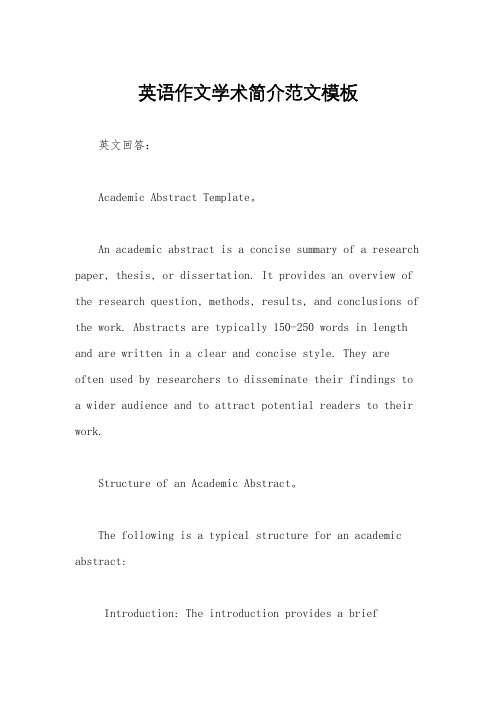
英语作文学术简介范文模板英文回答:Academic Abstract Template。
An academic abstract is a concise summary of a research paper, thesis, or dissertation. It provides an overview of the research question, methods, results, and conclusions of the work. Abstracts are typically 150-250 words in length and are written in a clear and concise style. They are often used by researchers to disseminate their findings to a wider audience and to attract potential readers to their work.Structure of an Academic Abstract。
The following is a typical structure for an academic abstract:Introduction: The introduction provides a briefoverview of the research topic and the research question being addressed.Methods: The methods section describes the research design, data collection methods, and data analysis techniques used in the study.Results: The results section presents the key findings of the study, including any statistical tests or other analyses that were conducted.Conclusions: The conclusions section summarizes the main findings of the study and discusses their implications.Tips for Writing an Effective Abstract。
academic writing 学术英语写作

学术英语写作是学术界中常用的书面语言,主要用于发表研究论文、学术论文、会议论文等。
学术英语写作需要遵循一定的规范和格式,包括文献引用、语言表达、逻辑结构等方面。
学术英语写作要求清晰、准确、严谨地表达学术观点和研究成果,同时要遵守学术道德和规范,避免抄袭、剽窃等行为。
学术英语写作需要具备一定的学术素养和英语语言能力。
作者需要具备相关领域的学术背景和专业知识,能够准确理解和阐述研究问题、实验结果和结论等。
同时,作者需要具备较高的英语语言水平,能够清晰、准确地表达学术观点和研究成果,并能够正确使用相关的学术术语和表达方式。
学术英语写作需要注重逻辑性和条理性。
在写作过程中,作者需要遵循一定的逻辑结构和表达方式,确保文章思路清晰、条理分明。
同时,作者需要注重推理和论证的严密性,确保结论和观点的正确性和可靠性。
总之,学术英语写作是学术界中非常重要的技能之一,对于学术研究和成果的传播都具有重要意义。
作者需要不断提高自己的学术素养和英语语言能力,掌握学术英语写作的规范和技巧,才能写出高质量的学术论文和研究成果。
学术英语写作

学术英语写作学术英语写作范文也许你的英语作文写的好,可是却不代表学术英语写作你就能写好。
下面,店铺为大家送上一篇学术英语写作范文及其提高技巧。
学术英语写作范文:I disagree strongly with the idea that the same amount of money should go to university sports activities as to university libraries. Although playing sports is a wonderful way to learn about teamwork, strategy and reaching your goals, it should not be the principal focus of a university education.Students need the most up-to-date library facilities available to get the best education. Many of those facilities are very expensive to buy and maintain. These include computerized programs and access to internet research databases that students can use to find information all around the world. If a university is only offering its students resources of a decade ago, it’s depriving those students of a tremendous amount of information.Even the book and magazine budget of universities has gone up tremendously in last decade. More is being published on every subject, and every university wants to have this information available to its students.It also costs money for universities to keep their libraries open. Students need to have access to all the libraries' research tools as much of time as possible. Because students are young and can stay up all night studying, many universities are starting to leave their libraries open all night during exam periods. This costs money, because the staff has to be paid extra to be there. It also costs money to run the building (electricity, heat) duringthat time.Students at universities are only going to benefit from their education if they can get to all the tools they need to learn. Sports are secondary to the resources that students need from university libraries. For this reason, libraries should always be better funded than sport activities.学术英语写作提高技巧:1.大量的读,而且要读最好的材料在读写部分,阅读是输入,写作是输出,而输入部分包含以下层面:知识背景,思辨模式。
学术英语写作的结构
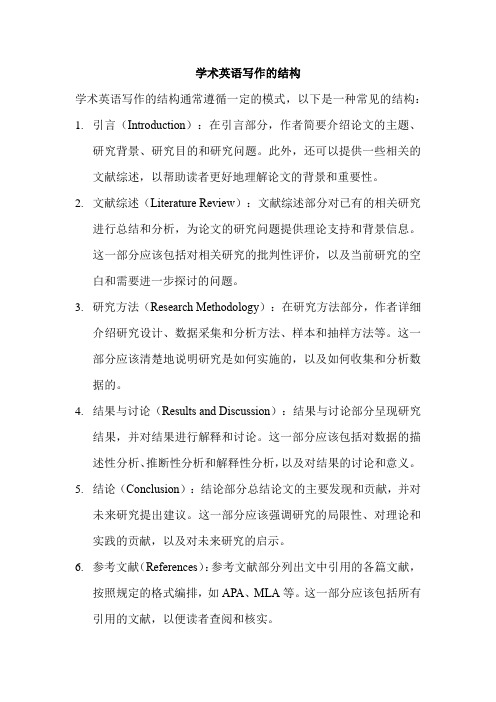
学术英语写作的结构
学术英语写作的结构通常遵循一定的模式,以下是一种常见的结构:1.引言(Introduction):在引言部分,作者简要介绍论文的主题、
研究背景、研究目的和研究问题。
此外,还可以提供一些相关的文献综述,以帮助读者更好地理解论文的背景和重要性。
2.文献综述(Literature Review):文献综述部分对已有的相关研究
进行总结和分析,为论文的研究问题提供理论支持和背景信息。
这一部分应该包括对相关研究的批判性评价,以及当前研究的空白和需要进一步探讨的问题。
3.研究方法(Research Methodology):在研究方法部分,作者详细
介绍研究设计、数据采集和分析方法、样本和抽样方法等。
这一部分应该清楚地说明研究是如何实施的,以及如何收集和分析数据的。
4.结果与讨论(Results and Discussion):结果与讨论部分呈现研究
结果,并对结果进行解释和讨论。
这一部分应该包括对数据的描述性分析、推断性分析和解释性分析,以及对结果的讨论和意义。
5.结论(Conclusion):结论部分总结论文的主要发现和贡献,并对
未来研究提出建议。
这一部分应该强调研究的局限性、对理论和实践的贡献,以及对未来研究的启示。
6.参考文献(References):参考文献部分列出文中引用的各篇文献,
按照规定的格式编排,如APA、MLA等。
这一部分应该包括所有引用的文献,以便读者查阅和核实。
以上是一种常见的学术英语写作结构,但具体的结构安排可能因学科领域、论文类型和个人偏好而有所不同。
在写作时,作者应该根据论文的具体要求和规范进行适当的调整。
学术英语写作的特点

学术英语写作的特点
学术英语写作具有以下几个特点:
1. 准确性:学术英语写作要求表达准确、清晰,避免使用模糊、
含混或错误的语言。
作者需要对所研究的领域有深入的了解,并使用
正确的术语和措辞来表达自己的观点。
2. 严谨性:学术英语写作需要遵循严格的逻辑和结构,包括引言、方法、结果和讨论等部分。
每个部分都需要有明确的目的和内容,并
且需要遵循相应的学术规范和标准。
3. 客观性:学术英语写作要求作者保持客观、中立的态度,避免
使用主观的语言和情感色彩较浓的措辞。
作者需要基于事实和证据来
阐述自己的观点,并对其他观点进行客观的评价和比较。
4. 正式性:学术英语写作通常使用较为正式的语言和措辞,避免
使用口语化、俚语化或过于简单的表达方式。
同时,学术英语写作也
需要遵循相应的文体和格式要求,如引用文献、标注出处等。
5. 简洁性:学术英语写作要求简洁明了,避免使用冗长、复杂或
晦涩难懂的语言。
作者需要用简洁的语言表达复杂的思想和观点,并
尽可能减少不必要的重复和废话。
学术英语写作需要作者具备扎实的专业知识、严谨的逻辑思维和良好的语言表达能力,以确保文章的准确性、客观性和正式性。
学术英语写作分类

学术英语写作分类?
答:学术英语写作主要有以下几种分类:
1. 研究论文(Research Paper):主要用来报告复杂的研究,展示研究结果和过程,常常包括引言、文献综述、方法、结果、讨论等部分。
2. 综述论文(Review Paper):对某一主题或领域进行全面的概述,通常包括对已有研究的批判性分析和综合。
3. 短篇报告(Short Communication):比研究论文简短,通常用来报告初步的研究结果或者一项研究的进展。
4. 海报展示(Poster Presentation):一种视觉化的学术报告方式,常常在学术会议上进行展示,包括研究目的、方法、结果和结论的简要说明。
5. 期刊论文(Journal Paper):发表在学术期刊上的论文,通常经过严格的同行评审,包括原创性研究、综述、评论等。
6. 学位论文(Thesis or Dissertation):为了获得硕士或博士学位而写的论文,通常包括大量的原创性研究和对该领域的深入理解。
请注意,以上分类可能会因不同的学科领域或期刊要求而有所不同。
另外,在撰写学术论文时,应遵循一定的格式和结构,并确保使用正确和专业的学术语言。
以上是关于学术英语写作分类的信息,希望对您有所帮助。
英语学术论文写作范文 学术英语写作 范文17篇
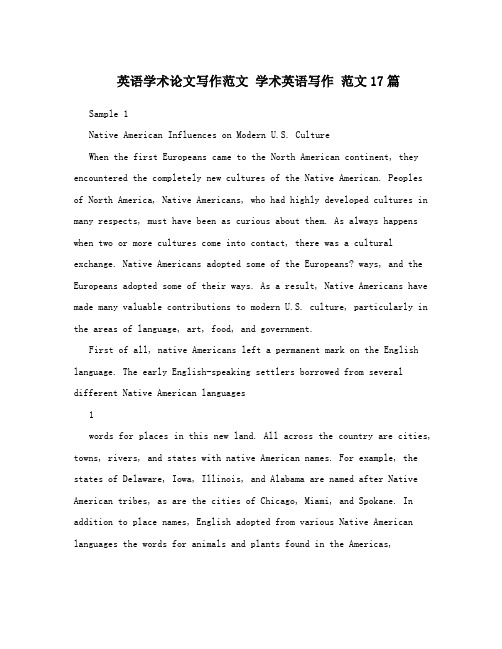
英语学术论文写作范文学术英语写作范文17篇Sample 1Native American Influences on Modern U.S. CultureWhen the first Europeans came to the North American continent, they encountered the completely new cultures of the Native American. Peoples of North America, Native Americans, who had highly developed cultures in many respects, must have been as curious about them. As always happens when two or more cultures come into contact, there was a cultural exchange. Native Americans adopted some of the Europeans? ways, and the Europeans adopted some of their ways. As a result, Native Americans have made many valuable contributions to modern U.S. culture, particularly in the areas of language, art, food, and government.First of all, native Americans left a permanent mark on the English language. The early English-speaking settlers borrowed from several different Native American languages1words for places in this new land. All across the country are cities, towns, rivers, and states with native American names. For example, the states of Delaware, Iowa, Illinois, and Alabama are named after Native American tribes, as are the cities of Chicago, Miami, and Spokane. In addition to place names, English adopted from various Native American languages the words for animals and plants found in the Americas,Chipmunk, moose, raccoon, skunk, tobacco, and squash are just a few examples.Although the vocabulary of English is the area that shows the most Native Americaninfluence, it is not the only area of U.S. culture that has been shaped by contact with NativeAmericans. Art if another area of important Native American contributions. Wool rugs woven by women of the Navajo Tribe in Arizona and New Mexico are highly valued works of art in the United States. Native American jewelry made from silver and turquoise is also very popular and very expensive. Especially in the western and southwestern regions of the United States, native crafts such as pottery, leather products, and beadwork can be found in many homes. Indeed, native art and handicrafts are a treasured2part of U.S. culture.In addition to language and art, agriculture is another area inwhich Native Americans had a great and lasting influence on the peoples who arrived here from Europe, Africa, and Asia. Being skilled farmers, the Native Americans of North America taught the new comers many things about farming techniques and crops. Every U.S. schoolchild has heard the story of how Native Americans taught the first settlers to place a dead fish in a planting hole to provide fertilizer for the growing plant. Furthermore, they taught the settlers irrigation methods and croprotation. Many of the foods people in the United States eat today were introduced to the Europeans by Native Americans. For example, corn and chocolate were unknown in Europe. Now they are staples in the U.S. diet.Finally, it may surprise some people to learn that citizens of the United States are also indebted to the native people for our form of government. The Iroquois, who were an extremely large tribe with many branches called “nations”,had developed a highly sophisticated system of government to settle disputes that arose between the various branches. Five of the nationshad joined together in a confederation3called “The League of the Iroquois.” Under th e league, eachnation was autonomous in running its own internal affairs, but the nations acted as a unit when dealing with outsiders. The league kept the Iroquois from fighting among themselves and was also valuable in diplomatic relations with other tribes. When the 13 colonies were considering what kind of government to establish after they had wontheir independence from Britain,someone suggested that they use a system similar to that of the League of the Iroquois. Under this system, each colony or future state would be autonomous in managing its own affairs but would join forces with the other states to deal with matters that concerned them all. This is exactly what百度搜索“就爱阅读”,专业资料,生活学习,尽在就爱阅读网,您的在线图书馆happened. As a result, the presentfrom of government of the United States can be traced directly back to a Native American model.In conclusion, we can easily see from these few examples the extent of Native American influence on our language, our art forms, out eating habits, and our government. The people of the United States are deeply indebted to Native4Americans for their contributions to U.S. Culture.Exercise: Complete the outline by filling in the missing parts.Native American Influences on Modern U.S. CultureI. IntroductionThesis statement:___________________________________________________________ II. BodyA. Native Americans left a permanent mark on the English language.1. Names of places-cities, towns, rivers, and statesa. States: Delaware, Iowa, Illinois, Alabamab. Cities: Chicago, Miami, Spokane2. Names of animals and plantsa. Animals: chipmunk, moose, raccoon, skunkb. Plants: tobacco, squashB._____________________________________________________________1. Navajo rugs2. Silver and turquoise jewelry3.5______________________________________________________________a. Potteryb._____________________________________________________c._____________________________________________________c.______________________________________________________________1. Farming techniquesa._________________________________________________b. ________________________________________________2._____________________________________________________a._________________________________________________b. ________________________________________________6D. _1. Iroquois-large tribe with many branches (“nations”) Needed to settle disputes among various branches2. Five nations formed League of Iroquoisa._________________________________________________b. Acted together when dealing with outsiders3. After independence, 13 colonies adopted similar system.a. Each colony (future state) was autonomous in managing own affairs.b.______________________________________________________III. Conclusion___________________________________________________________百度搜索“就爱阅读”,专业资料,生活学习,尽在就爱阅读网,您的在线图书馆Sample 2:At the MoviesYou Are Where You Sit: Seating Choice Can Tell a Lot about a Person!71 When he goes to the movies, Ravel Centeno likes to sit on theaisle and stretch his feet out-a fact that by itself speaks volumesabout his personality, according to a new study. The study, commissioned by the British movie theater company Odeon, examined how theater seating habits reflect personality. And as the summer movie season reaches its zenith, the research says you are where you sit. Psychologist Donna Dawson divided moviegoers into four different personality types based on their seating preferences and cited examples of movie characters who fit those types.2 Those who sit on the aisle, like Centeno, are “detached observers”-people who like to have their own space, who are observers and tend to be quieter. “That?s funny, because I?m a writer,” Centeno said Thursday as he waited to see AI. atthe CineplexOdeon at Universal CityWalk. “So that?s what I do (observe people).” One celluloid example of a detached observer, said Dawson, is Jack Nicholson?s Melvin Udall character in As Good as It Gets.3 Other personality types, according to Dawson:4 The “front row film fanatic”: Extroverted, assertive, and8competitive, these are people who like to see movies with others,not on their own. An example from the movies might be Mike Meyers?s Austin Powers or Julia Roberts?s ErinBrockovich.5 The”middle-of-the-roaders”: These are the people wholike to sit in the middle, fittingly. They are people who areflexible and try to get along with others, such as Gwyneth Paltrow?s Emma. Gloria and Tom Candelaria of Redlands say that seems to fit them. “We like the middle because it?s not too far back and not too close to the front,” Gloria Candelaria said as she scanned the marquee at CityWalk. Tom Candelaria said the “middle-of-the-roader” label seems to fit them because “we?re easygoing.”6 The “invisible rebels”: Those who sit far in the back are people who are rebellious and like excitement but don?t necessary seek the limelight, the study said. A typical example is ClintEastwood?s Man with No Name and Sigourney Weaver?s Lt. Ripley in the Alien films. “The back row is,where things happen; it?s an exciting area of danger and lots of passionate smooching,” Dawson said in the Odeon report. “It tends to attract people who are rebellious.”97 For some people, though, sometimes a chair i s just a chair. “I don?t knowwherever there?s an empty seat,” said filmgoer Chris Marshall of Lake Hollywood, when asked where he likes to sit. “That works for me.”Questions About the Organization1. What kind of introduction does this newspaper article have?a. It is a funnel introduction-it begins with a general statement and narrows down to the thesis statement.b. It begins with an example and ends with the thesis statement.c. It explains the reasons for the study and ends with the thesis statement.2. What kind of conclusion does it have?a. It summarizes the four main personality types.b. It gives the writer?s opinion on the study.c. It gives an example that contrasts with the main points.3. What words in the thesis statement indicate that the article uses logical division of ideas as a百度搜索“就爱阅读”,专业资料,生活学习,尽在就爱阅读网10,您的在线图书馆pattern of organization?About the Support4. What two kinds of supporting details are used in this article?_________ and _________5. The psychologist who made the study used one kind of support, and the writer of the article reporting the results of the study used another kind. Which person used which kind?a. The psychologist used _b. The writer used _About the Content6. How do we know if the psychologist is correct? Does the article mention the methods she used in her study to match seating preference and personality type, or does it report only the results?百度搜索“就爱阅读”,专业资料,生活学习,尽在就爱阅读网,您的在线图书馆Sample 3Culture ShockMoving to a new country can be an exciting, even exhilarating experience. In a newenvironment, you somehow feel more alive: seeing new11sights, eating new food, hearing theforeign sounds of a new language, and feeling a different climate against your skin stimulate your senses as never before. Soon, however, this sensory bombardment becomes sensory overload. Suddenly, new experiences seem stressful rather than stimulating, and delight turns intodiscomfort. This is the phenomenon known as culture shock. Culture shock is more than jet lag or homesickness, and it affects nearly everyone who enters a newculture-tourists, business travelers, diplomats, and students alike. Although not everyone experiences culture shock in exactly the same way, many experts agree that it has roughly five stages.In the first stage, you are excited by your new environment. You experience some simple difficulties such as trying to use the telephone or public transportation, but you consider these small challenges that you can quickly overcome. Your feelings about the new culture are positive, so you are eager to make contact with people and to try new foods.Sooner or later, differences in behavior and customs become more noticeable to you. This is the second stage of culture shock. Because you do not know the social customs12of the new culture, you may find it difficult to make friends. For instance, you do not understand how to make “small talk,” so it ishard to carry on a casual, get-acquaintedconversation. One day in the schoolcafeteria, you overhear a conversation. You understand all the words, but you do not understand the meaning. Why is everyone laughing? Arethey laughing at you or at some joke that you did not understand? Also, you aren?t always sure how to act while shopping. Is this store self-service, or should you wait for a clerk to assist you? If you buy a sweater in the wrong size, can you exchange it? These are not minor challenges; they are major frustrations.In the third stage, you no longer have positive feelings about the new culture. You feel that you have made a mistake in coming here. Making friends hasn?t been easy, so you begin to feel lonely and isolated. Now you want to be with familiar people and eat familiar food. You begin to spend most of your free time with students from your home country, and you eat in restaurants that serve your native food. In fact, food becomes an obsession, and you spend a lot of time planning, shopping for, and cooking food from home.You know that you are in the fourth stage of culture shock13when you have negative feelings about almost everything. In this stage, you actively reject the new culture. You become critical, suspicious, and irritable. You believe that people are unfriendly, thatyour landlord is trying to cheat you, that your teachers do not like you, and that the food is making you sick. In fact, you may actually develop stomachaches, headaches, sleeplessness, lethargy, or other physical symptoms.Finally, you reach the fifth stage. As your language skills improve, you begin to have somesuccess in meeting people and in negotiating situations. You areable to exchange the sweater that was too small, and you cansuccessfully chat about the weather with a stranger on the bus. Yourself-confidence grows. After realizing that you cannot change your surroundings, you begin to accept the differences and tolerate them. For instance, the food will never be as tasty as the food in your home country, but you are now able to eat and sometimes even enjoy many dishes. You may not like the way some people in your host country dress or behave in public, but you do not regard their clothes and behavior as wrong-just different.14Concluding Paragraph A百度搜索“就爱阅读”,专业资料,生活学习,尽在就爱阅读网,您的在线图书馆To sum up, culture shock is a veryreal phenomenon that has been studied for more than 30 years by psychologists and anthropologist$. Its five phases are (1) positive feelings toward the new culture, (2) awareness of small differences, (3) growing discomfort and need for contact with home culture, (4) negativefeelings, and (5) acceptance and adjustment. Symptoms may vary, and not all people experience all five phases. In the end, however, people who suffer culture shock are stronger from having overcome the difficulties and frustrations of adapting to life in a new land. Concluding Paragraph BIn conclusion, nearly everyone moving to a new country feels some degree of culture shock. Symptoms may vary, and not all people experience all five stages. Newcomers with a strong support group may feel at home immediately in the new culture, while others may take months to feel comfortable. Staying in touch with friends and family, keeping a positive attitude, and, above all, learning the language as soon as possible are ways to overcome the15difficulties and frustrations of adapting to life in a new land.Exercise:1. Which concluding paragraph best suits the passage and why?2. Which concluding paragraph is a summary of the subtopics? Which one paraphrases the thesisstatement?3. Which concluding paragraph gives suggestions? Which one makes a prediction?百度搜索“就爱阅读”,专业资料,生活学习,尽在就爱阅读网,您的在线图书馆Sample 4: Cause and Effect百度搜索“就爱阅读”,专业资料,生活学习,尽在就爱阅读网,您的在线图书馆百度搜索“就爱阅读”,专业资料,生活学习,尽在就爱阅读网,您的在线图书馆Sample 5: Cause and Effect16百度搜索“就爱阅读”,专业资料,生活学习,尽在就爱阅读网,您的在线图书馆Sample 6: Comparison百度搜索“就爱阅读”,专业资料,生活学习,尽在就爱阅读网,您的在线图书馆百度搜索“就爱阅读”,专业资料,生活学习,尽在就爱阅读网,您的在线图书馆Sample 7: ComparisonCLASSROOM LEARNING AND INTERNETBASEDTEACHINGSince the late 1990s internet-based teaching (also known as e-education) has emerged as a potential rival to traditional classroom learning. It normally involves having access to a secure site on the internet where a graded series of lessons are available, and which have assignments sent and returned by email. Although on-line courses are now offered by many institutions, it is by no means clear that they offer real advantages compared to classroom education. Little research has been done so far on their effectiveness, but this17essay sets out to examine the arguments on both sides and attemptsto draw conclusions from them.Two main advantages of internet use in education are put forward. Firstly, it is seen as more economical, in that once a course is prepared, it can be used by large numbers of students. The savings made by not having to employ so many teachers should be reflected in cheaper course fees. The second benefit is convenience; instead of having to attend classes at fixed times and places, students are free to study when they choose and progress at their own pace. Furthermore, by studying from home there is no need to travel to the college or university, saving both time and money. A student living in a small town in China, for example, can now study a course at an American college without the worry of travelling, accommodation or homesickness.Despite the considerations mentioned above, classroom learning shows no signs of being replaced by e-learning. It seems that face-to-face contact with a teacher is still widely regarded as the best way for students to make progress, despite the expense and inconvenience involved. Not only the personal contact with a teacher, but also the support and18encouragement gained from being part of a class may be one reasonfor this. Membership of a group may also create a useful spirit of competition, which stimulates learning.Given the increasing pressure on university places in many countries, internet-based teaching is often seen as a convenient development. However, e-learning eliminates personal contact and travel from education, which are possibly the aspects many students value. Sittingat home working on a computer may be economical, but clearly cannot replace the social experience of attending courses. However, there are many people who are unable, either through work or family commitments,or due to lack of funds, to go to classes, and who would clearly find internet learning beneficial. On-line courses can also be used tosupport taught courses, for instance by providing access to extra materials. In many ways these kinds of courses are similarto ,universities of the air?, such as Britain?s OpenUniversity, which have developed distance learning so successfullyin the last 40 years.Faced by growing demand for university places, more institutions are likely to develop on-line courses, but the apparent benefits of e-learning may be less than are19generally believed. Students seem to value the personal contact ofthe classroom highly, despite its cost andinconvenience. There may be a role for internet-based courses to supplement teacher-taught ones, and certainly for people with other commitments they will be the only practical option. There is an urgentneed for research on the effectiveness of this type of learning, which should help maximise its advantages in the future.(Approximately 550 words)百度搜索“就爱阅读”,专业资料,生活学习,尽在就爱阅读网,您的在线图书馆Sample 8: Argument百度搜索“就爱阅读”,专业资料,生活学习,尽在就爱阅读网,您的在线图书馆Now complete the outline of the model essay:Separating the Sexes, Just for the Tough YearsI. Introduction (explanation of the issue)Thesis statement:20_______________________________________II. BodyA. Opposing argument 1Opponents of single-sex education claim that test scores show that there is no advantage to all-girl or all-boy classes.Rebuttal to argument 11. Research is inconclusive-show opposite results2. Other results that cannot be calculateda. Girls____________________________________________________________________ _____________________________________________________________________ ____b. Boys____________________________________________________________________ ____________________________________________________________________ ______B. Opposing argument2____________________________________________________________21Rebuttal to argument 2_________________________________________________________a. Settling squabbles with siblingsb. Negotiating with opposite-sex parent百度搜索“就爱阅读”,专业资料,生活学习,尽在就爱阅读网,您的在线图书馆C. Opposing argument 3_________________________________________________________Rebuttal to argument 3___________________________________________________________a._______________________________________________________b. Teachers call on boys more oftenIII.Conclusion1. Same-sex classes provide a better learning environmentReasonsa. Boys and girls___________________________________________________22_____________________________________________________________________________ ______ b.Girl________________________________________________________________ _____ c. Boys____________________________________________________________________2.____________________________________________________________________ __3.____________________________________________________________________ _____百度搜索“就爱阅读”,专业资料,生活学习,尽在就爱阅读网,您的在线图书馆Sample 9A major change that has occurred in the Western family is an increased incidence in divorce. Whereas in the past, divorce was a relatively rare occurrence, in recent times it has become quite commonplace. This change is borne out clearly in census figures. For example thirty years ago in Australia, only one marriage in ten ended in divorce;23nowadays the figure is more than one in three (Australian Bureau of Statistics, 1996: p.45). A consequence of this change has been a substantial increase in the number of single parent families and the attendant problems that this brings (Kilmartin, 1997).An important issue for sociologists, and indeed for all of society,is why these changes in marital patterns have occurred. In this essay I will seek to critically examine a number of sociological explanationsfor the …divorce phenomenon? and also consider the social policy implications that each explanation carries with it. It will be arguedthat the best explanations are to be found within a broad socio-economic framework.One type of explanation for rising divorce has focused on changes in laws relating to marriage. For example, Bilton, Bonnett and Jones (1987) argue that increased rates of divorce do notnecessarily indicate that families are now more unstable. It is possible, they claim, that there has always been a degree of marital instability. They suggest that changes in the law have been significant, because they have provided unhappily married24couples with …access to a legal solution to pre-existentmarital problems? (p.301). Bilton et al. therefore believe that changes in divorce rates can be best explained in terms of changes inthe legal system. The problem with this type of explanation however, is that it does not consider why these laws have changed in the first place.It could be argued that reforms to family law, as well as the increased rate of divorce that has accompanied them, are the product of more fundamental changes in society.Another type of explanation is one that focuses precisely on these broad societal changes. For example, Nicky Hart (cited in Haralambos, 1995) argues that increases in divorce and marital breakdown are the result of economic changes that have affected the family. One example of these changes is the raised material aspirations of families, which Hart suggests has put pressure on both spouses to become wage earners. Women as a result have been forced to become both homemakers and economic providers. According to Hart, the contradiction of these two roles has lead to conflict and this is the main cause of marital breakdown. It would appear that Hart?s explanation cannot account for all cases of divorce - for example, marital breakdown is liable to occur25in families where only the husband is working. Nevertheless, her approach, which is to relate changes in family relations to broader social forces, would seem to be more probing than one that looks only at legislative change.The two explanations described above have very differentimplications for social policy,especially in relation to how the problem of increasing marital instability might be dealt with. Bilton et al. (1995) offer a legal explanation and hence would see the solutions also beingdetermined in this domain. If rises in divorce are thought to be the consequence of liberal divorce laws, the obvious way to stem this riseis to make them less obtainable. This approach, oneimagines, would lead to a reduction in divorce statistics; however, it cannot really be held up as a genuine solution to the problems of marital stress and breakdown in society. Indeed it would seem to be a solution directed more at symptoms than addressing fundamental causes.Furthermore, the百度搜索”就爱阅读”,专业资料,生活学习,尽在就爱阅读网26,您的在线图书馆experience of social workers,working in the area of family welfare suggests that restricting a couple?s access to divorce would in some cases serve only to exacerbate existing marital problems (Johnson, 1981). In those cases where violence is involved, the consequences could be tragic. Apart from all this, returning to more restrictive divorce laws seems to be a solution little favoured by Australians. (Harrison, 1990).Hart (cited in Haralambos, 1995), writing from a Marxist-feminist position, traces marital conflict to changes in the capitalist economic system and their resultant effect on the roles of men and women. It is difficult to know however, how such an analysis might be translated into practical social policies. This is because the Hart program would appear to require in the first place a radical restructuring of the economic system. Whilst this may be desirable for some, it is not achievable inthe present political climate. Hart is right however, to suggest that much marital conflict can be linked in some way to the economic circumstances of families. This is borne out in many statistical surveys which show consistently that rates of divorce are higher among socially disadvantaged families27(McDonald, 1993). This situation suggests then that social policies need to be geared to providing support and security for these types of families. It is little cause foroptimism however, that in recent years governments of all persuasions have shown an increasing reluctance to fund social welfare programs of this kind.It is difficult to offer a comprehensive explanation for the growing trend of marital breakdown; and it is even more difficult to find solutions that might ameliorate the problems created by it. Clearly though, as I have argued in this essay, the most useful answers are to be found not within a narrow legal framework, but within a broadersocio-economic one.Finally, it is worth pointing out that, whilst we may appear to be living in a time of increased family instability, research suggests that historically, instability may have been the norm rather than the exception. As Bell and Zajdow (1997) point out, in the past, single parent and step families were more common than is assumed - although the disruptive influence then was not divorce, but the premature death of。
英语学术写作
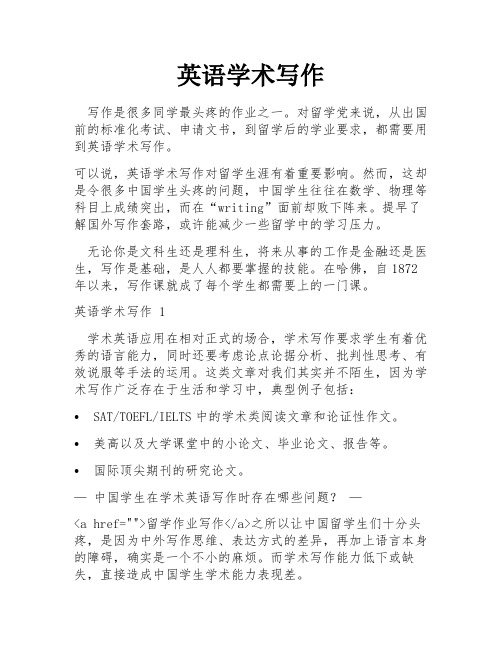
英语学术写作写作是很多同学最头疼的作业之一。
对留学党来说,从出国前的标准化考试、申请文书,到留学后的学业要求,都需要用到英语学术写作。
可以说,英语学术写作对留学生涯有着重要影响。
然而,这却是令很多中国学生头疼的问题,中国学生往往在数学、物理等科目上成绩突出,而在“writing”面前却败下阵来。
提早了解国外写作套路,或许能减少一些留学中的学习压力。
无论你是文科生还是理科生,将来从事的工作是金融还是医生,写作是基础,是人人都要掌握的技能。
在哈佛,自1872年以来,写作课就成了每个学生都需要上的一门课。
英语学术写作 1学术英语应用在相对正式的场合,学术写作要求学生有着优秀的语言能力,同时还要考虑论点论据分析、批判性思考、有效说服等手法的运用。
这类文章对我们其实并不陌生,因为学术写作广泛存在于生活和学习中,典型例子包括:• SAT/TOEFL/IELTS中的学术类阅读文章和论证性作文。
•美高以及大学课堂中的小论文、毕业论文、报告等。
•国际顶尖期刊的研究论文。
—中国学生在学术英语写作时存在哪些问题?—<a href="">留学作业写作</a>之所以让中国留学生们十分头疼,是因为中外写作思维、表达方式的差异,再加上语言本身的障碍,确实是一个不小的麻烦。
而学术写作能力低下或缺失,直接造成中国学生学术能力表现差。
下面我们就来看看中国学生在进行学术英语写作时存在的问题:用语不够正式学术写作中强调的正式性,指的是在学术英语中应采用惯用的词汇、结构、搭配等,不能像说口语一样随意发挥。
所有的学术作文都是需要进行修饰的。
看看这个例子:√ The Internet is dangerous because the large amount of information on it can be private information. Such information may be useful tools to criminals.互联网很危险,因为上面的大量信息都可能是个人隐私。
学术英语写作_范文17篇

Sample 1Native American Influences on Modern U.S. CultureWhen the first Europeans came to the North American continent, they encountered the completely new cultures of the Native American. Peoples of North America, Native Americans, who had highly developed cultures in many respects, must have been as curious about them. As always happens when two or more cultures come into contact, there was a cultural exchange. Native Americans adopted some of the Europeans’ ways, and the Europeans adopted some of their ways. As a result, Native Americans have made many valuable contributions to modern U.S. culture, particularly in the areas of language, art, food, and government.First of all, Native Americans left a permanent mark on the English language. The early English-speaking settlers borrowed from several different Native American languages words for places in this new land. All across the country are cities, towns, rivers, and states with Native American names. For example, the states of Delaware, Iowa, Illinois, and Alabama are named after Native American tribes, as are the cities of Chicago, Miami, and Spokane. In addition to place names, English adopted from various Native American languages the words for animals and plants found in the Americas, Chipmunk, moose, raccoon, skunk, tobacco, and squash are just a few examples.Although the vocabulary of English is the area that shows the most Native American influence, it is not the only area of U.S. culture that has been shaped by contact with Native Americans. Art is another area of important Native American contributions. Wool rugs woven by women of theNavajo Tribe in Arizona and New Mexico are highly valued works of art in the United States. Native American jewelry made from silver andturquoise is also very popular and very expensive. Especially in the western and southwestern regions of the United States, native craftssuch as pottery, leather products, and beadwork can be found in many homes. Indeed, native art and handicrafts are a treasured part of U.S. culture.In addition to language and art, agriculture is another area in which Native Americans had a great and lasting influence on the peoples who arrived here from Europe, Africa, and Asia. Being skilled farmers, the Native Americans of North America taught the new comers many things about farming techniques and crops. Every U.S. schoolchild has heard the story of how Native Americans taught the first settlers to place a dead fish in a planting hole to provide fertilizer for the growing plant. Furthermore, they taught the settlers irrigation methods and crop rotation. Many of the foods people in the United States eat today were introduced to the Europeans by Native Americans. For example, corn and chocolate were unknown in Europe. Now they are staples in the U.S. diet.Finally, it may surprise some people to learn that citizens of the United States are also indebted to the native people for our form of government. The Iroquois, who were an extremely large tribe with many branches called “nations”, had developed a highly sophisticated system of government to settle disputes that arose between the various branches. Five of the nations had joined together in a confederation called “The League of the Iroquois.” Under the league, each nation was autonomousin running its own internal affairs, but the nations acted as a unit when dealing with outsiders. The league kept the Iroquois from fightingamong themselves and was also valuable in diplomatic relations withother tribes. When the 13 colonies were considering what kind of government to establish after they had won their independence from Britain, someone suggested that they use a system similar to that of the League of the Iroquois. Under this system, each colony or future state would be autonomous in managing its own affairs but would join forces with the other states to deal with matters that concerned them all. This is exactly what happened. As a result, the present from of government of the United States can be traced directly back to a Native American model.In conclusion, we can easily see from these few examples the extent of Native American influence on our language, our art forms, out eating habits, and our government. The people of the United States are deeply indebted to Native Americans for their contributions to U.S. Culture.Exercise: Complete the outline by filling in the missing parts.Native American Influences on Modern U.S. CultureI. IntroductionThesis statement:___________________________________________________________II. BodyA. Native Americans left a permanent mark on the English language.1. Names of places-cities, towns, rivers, and statesa. States: Delaware, Iowa, Illinois, Alabamab. Cities: Chicago, Miami, Spokane2. Names of animals and plantsa. Animals: chipmunk, moose, raccoon, skunkb. Plants: tobacco, squashB. _____________________________________________________________1. Navajo rugs2. Silver and turquoise jewelry3. ______________________________________________________________a. Potteryb. _____________________________________________________c. _____________________________________________________C. ______________________________________________________________1. Farming techniquesa. _________________________________________________b. ________________________________________________2. _____________________________________________________a. _________________________________________________b. ________________________________________________D. ______________________________________________________________1. Iroquois-large tribe with many branches ("nations")Needed to settle disputes among various branches2. Five nations formed League of Iroquoisa. _________________________________________________b. Acted together when dealing with outsiders3. After independence, 13 colonies adopted similar system.a. Each colony (future state) was autonomous in managing own affairs.b. ______________________________________________________III. Conclusion___________________________________________________________ Sample 2:Culture ShockMoving to a new country can be an exciting, even exhilarating experience. In a new environment, you somehow feel more alive: seeingnew sights, eating new food, hearing the foreign sounds of a new language, and feeling a different climate against your skin stimulate your senses as never before. Soon, however, this sensory bombardment becomes sensory overload. Suddenly, new experiences seem stressfulrather than stimulating, and delight turns into discomfort. This is the phenomenon known as culture shock. Culture shock is more than jet lag or homesickness, and it affects nearly everyone who enters a new culture-tourists, business travelers, diplomats, and students alike. Although not everyone experiences culture shock in exactly the same way, many experts agree that it has roughly five stages.In the first stage, you are excited by your new environment. You experience some simple difficulties such as trying to use the telephone or public transportation, but you consider these small challenges that you can quickly overcome. Your feelings about the new culture are positive, so you are eager to make contact with people and to try new foods.Sooner or later, differences in behavior and customs become more noticeable to you. This is the second stage of culture shock. Because you do not know the social customs of the new culture, you may find it difficult to make friends. For instance, you do not understand how to make "small talk," so it is hard to carry on a casual, get-acquainted conversation. One day in the school cafeteria, you overhear a conversation. You understand all the words, but you do not understand the meaning. Why is everyone laughing? Are they laughing at you or at some joke that you did not understand? Also, you aren't always sure how to act while shopping. Is this store self-service, or should you waitfor a clerk to assist you? If you buy a sweater in the wrong size, canyou exchange it? These are not minor challenges; they are major frustrations.In the third stage, you no longer have positive feelings about the new culture. You feel that you have made a mistake in coming here. Making friends hasn't been easy, so you begin to feel lonely and isolated. Now you want to be with familiar people and eat familiar food. You begin to spend most of your free time with students from your home country, and you eat in restaurants that serve your native food. In fact, food becomes an obsession, and you spend a lot of time planning, shopping for, and cooking food from home.You know that you are in the fourth stage of culture shock when you have negative feelings about almost everything. In this stage, you actively reject the new culture. You become critical, suspicious, and irritable. You believe that people are unfriendly, that your landlord is trying to cheat you, that your teachers do not like you, and that the food is making you sick. In fact, you may actually develop stomachaches, headaches, sleeplessness, lethargy, or other physical symptoms.Finally, you reach the fifth stage. As your language skills improve, you begin to have some success in meeting people and in negotiating situations. You are able to exchange the sweater that was too small, and you can successfully chat about the weather with a stranger on the bus. Your self-confidence grows. After realizing that you cannot change your surroundings, you begin to accept the differences and tolerate them. For instance, the food will never be as tasty as the food in your home country, but you are now able to eat and sometimes even enjoy many dishes. You may not like the way some people in your host country dressor behave in public, but you do not regard their clothes and behavior as wrong-just different.Concluding Paragraph ATo sum up, culture shock is a very real phenomenon that has been studied for more than 30 years by psychologists and anthropologists. Its five phases are (1) positive feelings toward the new culture, (2) awareness of small differences, (3) growing discomfort and need for contact with home culture, (4) negative feelings, and (5) acceptance and adjustment. Symptoms may vary, and not all people experience all five phases. In the end, however, people who suffer culture shock are stronger from having overcome the difficulties and frustrations of adapting to life in a new land.Concluding Paragraph BIn conclusion, nearly everyone moving to a new country feels some degree of culture shock. Symptoms may vary, and not all people experience all five stages. Newcomers with a strong support group may feel at home immediately in the new culture, while others may take months to feel comfortable. Staying in touch with friends and family, keeping a positive attitude, and, above all, learning the language as soon as possible are ways to overcome the difficulties and frustrations of adapting to life in a new land.Exercise:1. Which concluding paragraph best suits the passage and why?2. Which concluding paragraph is a summary of the subtopics? Which one paraphrases the thesis statement?3. Which concluding paragraph gives suggestions? Which one makes a prediction?Sample 3At the MoviesYou Are Where You Sit: Seating Choice Can Tell a Lot about a Person!1 When he goes to the movies, Ravel Centeno likes to sit on the aisle and stretch his feet out-a fact that by itself speaks volumesabout his personality, according to a new study. The study, commissioned by the British movie theater company Odeon, examined how theater seating habits reflect personality. And as the summer movie season reaches its zenith, the research says you are where you sit. Psychologist Donna Dawson divided moviegoers into four different personality types based on their seating preferences and cited examples of movie characters who fit those types.2 Those who sit on the aisle, like Centeno, are "detached observers"-people who like to have their own space, who are observersand tend to be quieter. "That's funny, because I'm a writer," Centeno said Thursday as he waited to see AI. at the Cineplex Odeon at Universal CityWalk. "So that's what I do (observe people)." One celluloid example of a detached observer, said Dawson, is Jack Nicholson's Melvin Udall character in As Good as It Gets.3 Other personality types, according to Dawson:4 The "front row film fanatic": Extroverted, assertive, and competitive, these are people who like to see movies with others, not on their own. An example from the movies might be Mike Meyers's Austin Powers or Julia Roberts's Erin Brockovich.5 The “middle-of-the-roaders": These are the people who like to sit in the middle, fittingly. They are people who are flexible andtry to get along with others, such as Gwyneth Paltrow's Emma. Gloria and Tom Candelaria of Redlands say that seems to fit them. "We like the middle because it's not too far back and not too close to the front," Gloria Candelaria said as she scanned the marquee at CityWalk. Tom Candelaria said the "middle-of-the-roader" label seems to fit them because "we're easygoing."6 The "invisible rebels": Those who sit far in the back are people who are rebellious and like excitement but don't necessary seek the limelight, the study said. A typical example is Clint Eastwood's Man with No Name and Sigourney Weaver's Lt. Ripley in the Alien films. "The back row is, where things happen; it's an exciting area of danger and lots of passionate smooching," Dawson said in the Odeon report. "It tends to attract people who are rebellious."7 For some people, though, sometimes a chair is just a chair. "I don't know wherever there's an empty seat," said filmgoer Chris Marshall of Lake Hollywood, when asked where he likes to sit. "That works for me."Questions About the Organization1. What kind of introduction does this newspaper article have?a. It is a funnel introduction-it begins with a general statement and narrows down to the thesis statement.b. It begins with an example and ends with the thesis statement.c. It explains the reasons for the study and ends with the thesis statement.2. What kind of conclusion does it have?a. It summarizes the four main personality types.b. It gives the writer's opinion on the study.c. It gives an example that contrasts with the main points.3. What words in the thesis statement indicate that the article uses logical division of ideas as a pattern of organization?About the Support4. What two kinds of supporting details are used in this article?_________ and _________5. The psychologist who made the study used one kind of support, and the writer of the article reporting the results of the study used another kind. Which person used which kind?a. The psychologist used _b. The writer used _About the Content6. How do we know if the psychologist is correct? Does the article mention the methods she used in her study to match seating preference and personality type, or does it report only the results?Sample 4: Cause and EffectSample 5: Cause and EffectSample 6: ComparisonSample 7: ComparisonCLASSROOM LEARNING AND INTERNETBASED TEACHINGSince the late 1990s internet-based teaching (also known as e-education) has emerged as a potential rival to traditional classroom learning. It normally involves having access to a secure site on the internet where a graded series of lessons are available, and which have assignments sent and returned by email. Although on-line courses are now offered by many institutions, it is by no means clear that they offer real advantages compared to classroom education. Little research has been done so far on their effectiveness, but this essay sets out toexamine the arguments on both sides and attempts to draw conclusions from them.Two main advantages of internet use in education are put forward. Firstly, it is seen as more economical, in that once a course is prepared, it can be used by large numbers of students. The savings made by not having to employ so many teachers should be reflected in cheaper course fees. The second benefit is convenience; instead of having to attend classes at fixed times and places, students are free to study when they choose and progress at their own pace. Furthermore, by studying from home there is no need to travel to the college or university, saving both time and money. A student living in a small town in China, for example, can now study a course at an American college without the worry of travelling, accommodation or homesickness.Despite the considerations mentioned above, classroom learning shows no signs of being replaced by e-learning. It seems that face-to-face contact with a teacher is still widely regarded as the best way for students to make progress, despite the expense and inconvenience involved. Not only the personal contact with a teacher, but also the support and encouragement gained from being part of a class may be one reason for this. Membership of a group may also create a useful spirit of competition, which stimulates learning.Given the increasing pressure on university places in many countries, internet-based teaching is often seen as a convenient development. However, e-learning eliminates personal contact and travel from education, which are possibly the aspects many students value. Sitting at home working on a computer may be economical, but clearlycannot replace the social experience of attending courses. However, there are many people who are unable, either through work or family commitments, or due to lack of funds, to go to classes, and who would clearly find internet learning beneficial. On-line courses can also be used to support taught courses, for instance by providing access to extra materials. In many ways these kinds of courses are similar to‘universities of the air’, such as Britain’s Open University, which have developed distance learning so successfully in the last 40 years.Faced by growing demand for university places, more institutions are likely to develop on-line courses, but the apparent benefits of e-learning may be less than are generally believed. Students seem to value the personal contact of the classroom highly, despite its cost and inconvenience. There may be a role for internet-based courses to supplement teacher-taught ones, and certainly for people with other commitments they will be the only practical option. There is an urgent need for research on the effectiveness of this type of learning, which should help maximize its advantages in the future.(Approximately 550 words)Sample 8: ArgumentNow complete the outline of the model essay: Separating the Sexes, Just for the Tough YearsI. Introduction (explanation of the issue)Thesis statement: _______________________________________II. BodyA. Opposing argument 1Opponents of single-sex education claim that test scores show that there is no advantage to all-girl or all-boy classes.Rebuttal to argument 11. Research is inconclusive-show opposite results2. Other results that cannot be calculateda. Girls________________________________________________________________________________________________________________________________________ _____b.Boys _________________________________________________________________ ______________________________________________________________________ _______B. Opposing argument2____________________________________________________________ Rebuttal to argument 2_________________________________________________________a. Settling squabbles with siblingsb. Negotiating with opposite-sex parentC. Opposing argument 3_________________________________________________________Rebuttal to argument 3___________________________________________________________a. _______________________________________________________b. Teachers call on boys more oftenIII.Conclusion1. Same-sex classes provide a better learning environmentReasonsa. Boys and girls_______________________________________________________________________________________________________________________________ _______b.Girl____________________________________________________________________ _c. Boys____________________________________________________________________2.______________________________________________________________________3.________________________________________________________________________ _Sample 9A major change that has occurred in the Western family is an increased incidence in divorce. Whereas in the past, divorce was a relatively rare occurrence, in recent times it has become quite commonplace. This change is borne out clearly in census figures. For example thirty years ago in Australia, only one marriage in ten ended in divorce; nowadays the figure is more than one in three (Australian Bureau of Statistics, 1996: p.45). A consequence of this change has been a substantial increase in the number of single parent families and the attendant problems that this brings (Kilmartin, 1997).An important issue for sociologists, and indeed for all of society, is why these changes in marital patterns have occurred. In this essay I will seek to critically examine a number of sociological explanationsfor the 'divorce phenomenon' and also consider the social policy implications that each explanation carries with it. It will be arguedthat the best explanations are to be found within a broad socio-economic framework.One type of explanation for rising divorce has focused on changesin laws relating to marriage. For example, Bilton, Bonnett and Jones (1987) argue that increased rates of divorce do not necessarily indicate that families are now more unstable. It is possible, they claim, that there has always been a degree of marital instability. They suggest that changes in the law have been significant, because they have provided unhappily married couples with 'access to a legal solution to pre-existent marital problems' (p.301). Bilton et al. therefore believe that changes in divorce rates can be best explained in terms of changes inthe legal system. The problem with this type of explanation however, is that it does not consider why these laws have changed in the first place. It could be argued that reforms to family law, as well as the increased rate of divorce that has accompanied them, are the product of more fundamental changes in society.Another type of explanation is one that focuses precisely on these broad societal changes. For example, Nicky Hart (cited in Haralambos, 1995) argues that increases in divorce and marital breakdown are the result of economic changes that have affected the family. One example of these changes is the raised material aspirations of families, which Hart suggests has put pressure on both spouses to become wage earners. Womenas a result have been forced to become both homemakers and economic providers. According to Hart, the contradiction of these two roles has lead to conflict and this is the main cause of marital breakdown. It would appear that Hart's explanation cannot account for all cases of divorce - for example, marital breakdown is liable to occur in families where only the husband is working. Nevertheless, her approach, which is to relate changes in family relations to broader social forces, would seem to be more probing than one that looks only at legislative change.The two explanations described above have very differentimplications for social policy, especially in relation to how the problem of increasing marital instability might be dealt with. Bilton et al. (1995) offer a legal explanation and hence would see the solutions also being determined in this domain. If rises in divorce are thought to be the consequence of liberal divorce laws, the obvious way to stem this rise is to make them less obtainable. This approach, one imagines, would lead to a reduction in divorce statistics; however, it cannot really be held up as a genuine solution to the problems of marital stress and breakdown in society. Indeed it would seem to be a solution directed more at symptoms than addressing fundamental causes. Furthermore, the experience of social workers, working in the area of family welfare suggests that restricting a couple's access to divorce would in some cases serve only to exacerbate existing marital problems (Johnson, 1981). In those cases where violence is involved, the consequences could be tragic. Apart from all this, returning to more restrictive divorce laws seems to be a solution little favored by Australians. (Harrison, 1990).Hart (cited in Haralambos, 1995), writing from a Marxist-feminist position, traces marital conflict to changes in the capitalist economicsystem and their resultant effect on the roles of men and women. It is difficult to know however, how such an analysis might be translated into practical social policies. This is because the Hart program would appear to require in the first place a radical restructuring of the economic system. Whilst this may be desirable for some, it is not achievable in the present political climate. Hart is right however, to suggest that much marital conflict can be linked in some way to the economic circumstances of families. This is borne out in many statistical surveys which show consistently that rates of divorce are higher among socially disadvantaged families (McDonald, 1993). This situation suggests then that social policies need to be geared to providing support and security for these types of families. It is little cause for optimism however, that in recent years governments of all persuasions have shown an increasing reluctance to fund social welfare programs of this kind.It is difficult to offer a comprehensive explanation for the growing trend of marital breakdown; and it is even more difficult tofind solutions that might ameliorate the problems created by it. Clearly though, as I have argued in this essay, the most useful answers are to be found not within a narrow legal framework, but within a broadersocio-economic one.Finally, it is worth pointing out that, whilst we may appear to be living in a time of increased family instability, research suggests that historically, instability may have been the norm rather than the exception. As Bell and Zajdow (1997) point out, in the past, single parent and step families were more common than is assumed - although the disruptive influence then was not divorce, but the premature death of one or both parents. This situation suggests that in studying the modernfamily, one needs to employ a historical perspective, including the possibility of looking to the past in searching for ways of dealing with problems in the present.Sample 10Discuss why assignment essays are common assessment tasks in undergraduate tertiary coursework, and evaluate the effectiveness of assignments as an avenue for learning. (Word limit 500 words - 10% leeway) Please note that the APA referencing style is used in this sample essay.Assignment essays are developed from set questions that give students a period of time to research a topic and produce their answer with references to their sources of information. While there are some disadvantages with using assignment essays as an assessment tool, there are sound educational purposes underpinning this practice. This essay examines the reasons why assignment essays are beneficial for student learning and considers some of the problems with this method of assessment.Assignment essay tasks are set to assist students to develop mastery of their study subject. Firstly, assignment tasks enhance understandings about subject matter. Yang and Baker (2005) reason that "to master your learning materials and extend your understandings, you need to write about the meanings you gain from your research" (p. 1). Secondly, research (Jinx, 2004; Zapper, 2006) clearly demonstrates that students learn the writing conventions of a subject area while they are researching, reading and writing in their discipline. This activity。
学术英语作文万能模板范文
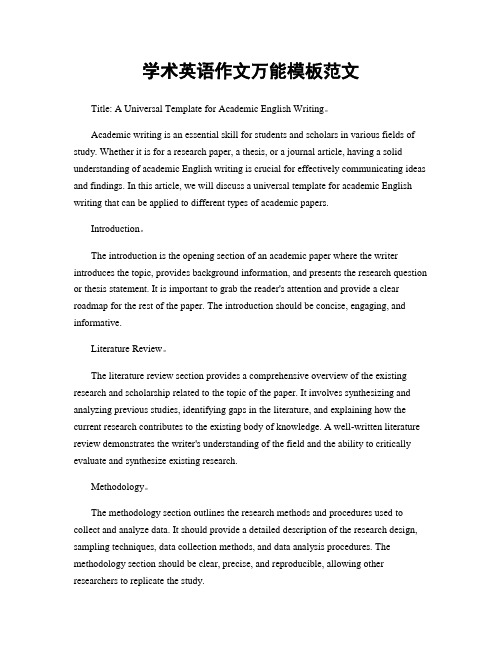
学术英语作文万能模板范文Title: A Universal Template for Academic English Writing。
Academic writing is an essential skill for students and scholars in various fields of study. Whether it is for a research paper, a thesis, or a journal article, having a solid understanding of academic English writing is crucial for effectively communicating ideas and findings. In this article, we will discuss a universal template for academic English writing that can be applied to different types of academic papers.Introduction。
The introduction is the opening section of an academic paper where the writer introduces the topic, provides background information, and presents the research question or thesis statement. It is important to grab the reader's attention and provide a clear roadmap for the rest of the paper. The introduction should be concise, engaging, and informative.Literature Review。
学术英语论文范文精选3篇(全文)
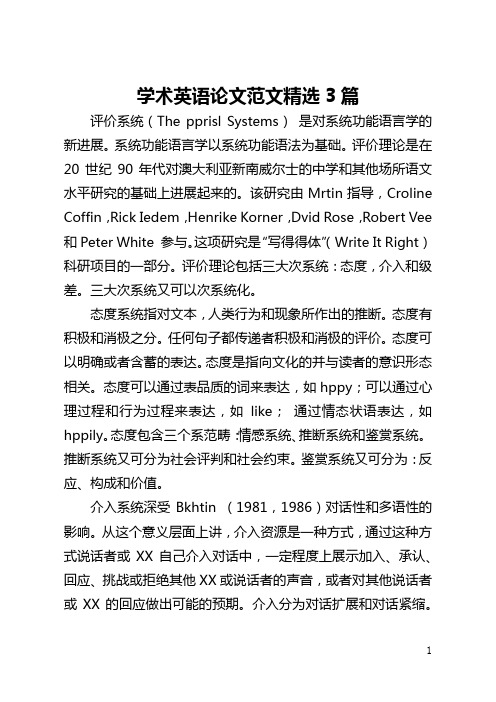
学术英语论文范文精选3篇评价系统(The pprisl Systems)是对系统功能语言学的新进展。
系统功能语言学以系统功能语法为基础。
评价理论是在20世纪90年代对澳大利亚新南威尔士的中学和其他场所语文水平研究的基础上进展起来的。
该研究由Mrtin指导,Croline Coffin,Rick Iedem,Henrike Korner,Dvid Rose,Robert Vee 和Peter White 参与。
这项研究是“写得得体”(Write It Right)科研项目的一部分。
评价理论包括三大次系统:态度,介入和级差。
三大次系统又可以次系统化。
态度系统指对文本,人类行为和现象所作出的推断。
态度有积极和消极之分。
任何句子都传递者积极和消极的评价。
态度可以明确或者含蓄的表达。
态度是指向文化的并与读者的意识形态相关。
态度可以通过表品质的词来表达,如hppy;可以通过心理过程和行为过程来表达,如like;通过情态状语表达,如hppily。
态度包含三个系范畴:情感系统、推断系统和鉴赏系统。
推断系统又可分为社会评判和社会约束。
鉴赏系统又可分为:反应、构成和价值。
介入系统深受Bkhtin (1981,1986)对话性和多语性的影响。
从这个意义层面上讲,介入资源是一种方式,通过这种方式说话者或XX自己介入对话中,一定程度上展示加入、承认、回应、挑战或拒绝其他XX或说话者的声音,或者对其他说话者或XX的回应做出可能的预期。
介入分为对话扩展和对话紧缩。
对话扩展又可次系统化为包容和归属;对话紧缩可次系统化为弃言和借言。
介入可以通过情态词、言剧性表达、模糊语等来实现,如my,it is sid tht等。
级差系统是对态度介入的程度的分级资源,包含语势和聚焦。
语势有强势和弱势之分,聚焦有明显和模糊之分。
级差可以通过一些表程度的词来实现,如some,plusible等。
3.语料本项研究的语料是60篇英文4.研究结果及分析本研究分别从三个次系统对语料进行分析:态度,介入,级差。
学术英语写作academic language

学术英语写作(Academic Language)是一种用于学术和专业领域的英语写作风格。
它具有以下特点:
- **准确性**:使用准确的词汇和语法,避免模糊或歧义。
- **专业性**:运用特定领域的专业术语和词汇,体现学术的专业性。
- **逻辑性**:结构清晰,段落之间有明确的逻辑关系。
- **客观性**:以客观的态度表达观点,避免主观情感和个人偏见。
- **正式性**:语言风格较为正式,避免口语化和随意的表达。
- **引用和参考**:正确引用他人的研究成果,以支持自己的观点并提供参考依据。
- **论证性**:通过论证和证据来支持观点,使文章具有说服力。
要提高学术英语写作水平,可以多阅读相关领域的学术文献,学习其写作风格和表达方式。
同时,注重语法和词汇的积累,不断练习写作,接受老师或同行的反馈,都有助于提升学术英语写作能力。
英语学术写作试题及答案

英语学术写作试题及答案一、选择题(每题2分,共10分)1. 在英语学术写作中,引用他人的观点时,以下哪个选项是正确的?A. 直接复制粘贴B. 用自己的话重述C. 只注明出处D. 以上都是答案:B2. 下列哪个选项不是英语学术写作中常见的段落结构?A. 主题句+支持句+例证句+结论句B. 问题句+分析句+解决方案句C. 观点句+反驳句+总结句D. 故事句+分析句+结论句答案:D3. 在英语学术写作中,以下哪个词汇是不合适的?A. HoweverB. ThereforeC. In my opinionD. Consequently答案:C4. 英语学术论文的参考文献应如何列出?A. 按照作者姓氏的字母顺序B. 按照引用的先后顺序C. 随意排列D. 按照出版年份答案:A5. 英语学术写作中,以下哪个选项是正确的论证方式?A. 只提供个人经验B. 只提供统计数据C. 结合个人经验和统计数据D. 只提供他人观点答案:C二、填空题(每题2分,共10分)6. 在英语学术写作中,使用第一人称时,应避免使用________。
答案:I, me, we, us7. 英语学术论文的标题应该________,以吸引读者的注意。
答案:简洁明了8. 英语学术写作中,段落的开头通常使用________来引导。
答案:主题句9. 在英语学术写作中,避免使用________来表达观点。
答案:绝对化词汇,如always, never10. 英语学术写作的结论部分应该________。
答案:总结主要观点并提出未来研究方向或实践意义三、简答题(每题10分,共20分)11. 简述英语学术写作中如何避免抄袭。
答案:避免抄袭的方法包括:使用引号标注直接引用的原文;对引用的内容进行适当的改写并注明出处;确保自己的论点和分析是原创的。
12. 描述英语学术写作中引用文献的步骤。
答案:引用文献的步骤包括:阅读并理解原始文献;在文中适当位置插入引用,并使用括号注明作者和出版年份;在文末提供完整的参考文献列表,包括作者、出版年份、文章标题、期刊名称、卷号、期号和页码。
英语学术论文写作30题
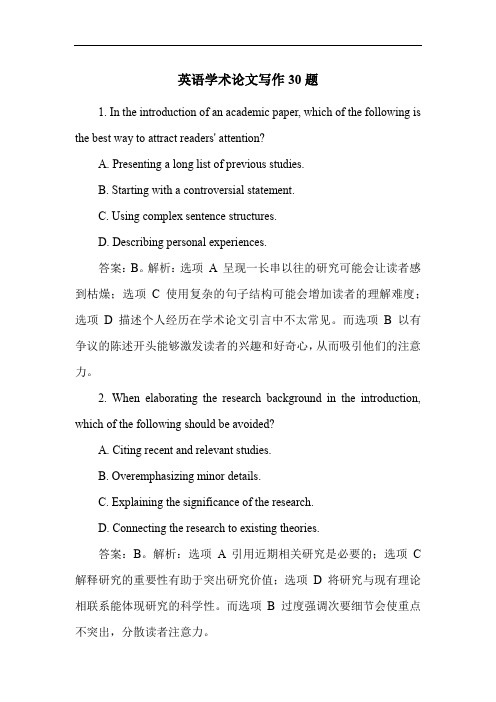
英语学术论文写作30题1. In the introduction of an academic paper, which of the following is the best way to attract readers' attention?A. Presenting a long list of previous studies.B. Starting with a controversial statement.C. Using complex sentence structures.D. Describing personal experiences.答案:B。
解析:选项 A 呈现一长串以往的研究可能会让读者感到枯燥;选项 C 使用复杂的句子结构可能会增加读者的理解难度;选项 D 描述个人经历在学术论文引言中不太常见。
而选项 B 以有争议的陈述开头能够激发读者的兴趣和好奇心,从而吸引他们的注意力。
2. When elaborating the research background in the introduction, which of the following should be avoided?A. Citing recent and relevant studies.B. Overemphasizing minor details.C. Explaining the significance of the research.D. Connecting the research to existing theories.答案:B。
解析:选项 A 引用近期相关研究是必要的;选项 C 解释研究的重要性有助于突出研究价值;选项D 将研究与现有理论相联系能体现研究的科学性。
而选项B 过度强调次要细节会使重点不突出,分散读者注意力。
3. Which of the following is an appropriate opening sentence for the introduction of an academic paper?A. "This paper will discuss an important topic."B. "In recent years, there has been a growing interest in this field."C. "I have always been interested in this subject."D. "The aim of this study is to solve a long-standing problem."答案:D。
学术英语写作包含的框架
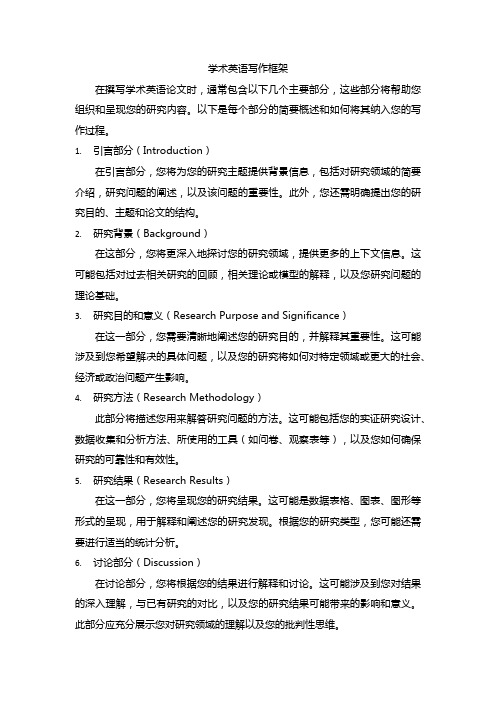
学术英语写作框架在撰写学术英语论文时,通常包含以下几个主要部分,这些部分将帮助您组织和呈现您的研究内容。
以下是每个部分的简要概述和如何将其纳入您的写作过程。
1.引言部分(Introduction)在引言部分,您将为您的研究主题提供背景信息,包括对研究领域的简要介绍,研究问题的阐述,以及该问题的重要性。
此外,您还需明确提出您的研究目的、主题和论文的结构。
2.研究背景(Background)在这部分,您将更深入地探讨您的研究领域,提供更多的上下文信息。
这可能包括对过去相关研究的回顾,相关理论或模型的解释,以及您研究问题的理论基础。
3.研究目的和意义(Research Purpose and Significance)在这一部分,您需要清晰地阐述您的研究目的,并解释其重要性。
这可能涉及到您希望解决的具体问题,以及您的研究将如何对特定领域或更大的社会、经济或政治问题产生影响。
4.研究方法(Research Methodology)此部分将描述您用来解答研究问题的方法。
这可能包括您的实证研究设计、数据收集和分析方法、所使用的工具(如问卷、观察表等),以及您如何确保研究的可靠性和有效性。
5.研究结果(Research Results)在这一部分,您将呈现您的研究结果。
这可能是数据表格、图表、图形等形式的呈现,用于解释和阐述您的研究发现。
根据您的研究类型,您可能还需要进行适当的统计分析。
6.讨论部分(Discussion)在讨论部分,您将根据您的结果进行解释和讨论。
这可能涉及到您对结果的深入理解,与已有研究的对比,以及您的研究结果可能带来的影响和意义。
此部分应充分展示您对研究领域的理解以及您的批判性思维。
7.结论部分(Conclusion)在结论部分,您将概括您的研究发现,重申您研究的重要性,并指出未来可能的研究方向。
此外,还可以讨论这些发现的可能应用和实践意义。
每个部分都有其特定的目的和内容,需要仔细考虑和精心撰写。
学术专著英语作文模板
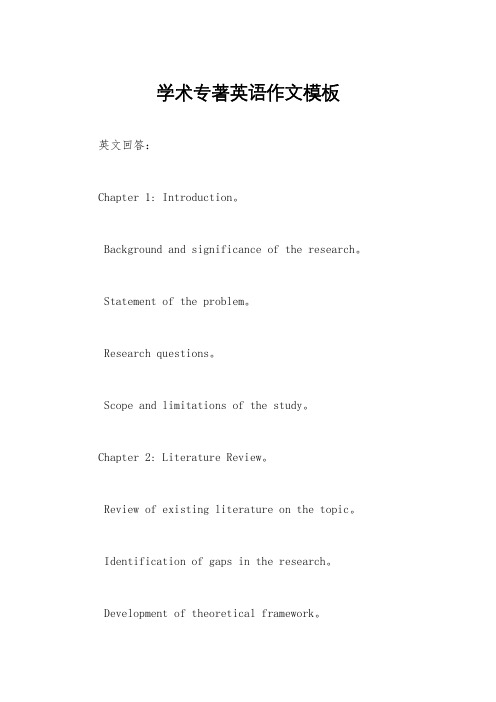
学术专著英语作文模板英文回答:Chapter 1: Introduction。
Background and significance of the research。
Statement of the problem。
Research questions。
Scope and limitations of the study。
Chapter 2: Literature Review。
Review of existing literature on the topic。
Identification of gaps in the research。
Development of theoretical framework。
Chapter 3: Methodology。
Description of the research design。
Sampling strategy and sample characteristics。
Data collection methods。
Data analysis techniques。
Chapter 4: Results。
Presentation and analysis of the research findings。
Discussion of the key findings。
Chapter 5: Discussion。
Interpretation of the research findings。
Implications for theory and practice。
Recommendations for future research。
Chapter 6: Conclusion。
Summary of the research findings。
Restatement of the research questions。
Concluding remarks。
学术英语写作特点

学术英语写作特点学术英语写作是一种专门用于学术交流和研究的写作风格。
它在语法、词汇、语言结构和逻辑等方面具有独特的特点,以确保信息传递的准确性和权威性。
本文将介绍学术英语写作的几个主要特点。
正式性和客观性学术英语写作强调正式性和客观性,要求作者使用正规的语言和规范的文体。
在语法和词汇方面,学术英语使用较为正式和古典的词汇和句式,以展示研究的严肃性和权威性。
此外,学术写作强调客观性,避免主观情感和个人观点的表达,而是依靠事实和证据来支持论点。
结构清晰和逻辑严谨学术英语写作对逻辑性和条理性有较高要求。
学术文章通常由引言、方法、结果和讨论等部分组成。
每个部分都有明确的目的和内容,且之间的关系要清晰明了。
作者需要合理安排段落和句子的次序,确保逻辑严谨和信息的顺畅传递。
使用学术词汇和专业术语学术英语写作中常用大量的学术词汇和专业术语。
这些词汇和术语精确、准确地表达特定的概念和观点。
在使用这些术语时,作者需要明确其含义,并在适当的上下文中使用。
学术术语的使用不仅可以提升文章的准确性和权威性,也使读者更容易理解和接受作者的观点。
引用和参考文献学术英语写作非常重视引用和参考文献。
学术文章需要引用其他学者的研究结果和观点,以支持自己的论点。
在引用时,需要按照一定的引用格式进行,如APA、MLA等。
同时,学术文章还需要提供参考文献列表,详细列出引用的文献信息,以便读者查证和深入研究。
具备学术论证和批判思维学术英语写作注重论证和批判思维。
作者需要通过逻辑推理和事实论证,支持自己的观点和研究结论。
同时,学术写作还需要具备批判思维,对已有研究进行评价和批判,指出其不足之处,并提出自己的改进和贡献。
精确和准确的语言表达学术英语要求语言表达精确和准确。
作者需要思考每个词汇和句子的含义,选择最合适的词语和表达方式。
此外,学术写作还需要小心使用相关的语法和标点符号,以确保句子结构清晰、逻辑严密。
总之,学术英语写作具有正式性、客观性、结构清晰、逻辑严谨、专业术语使用、引用参考文献、学术论证和批判思维、精确和准确的语言表达等特点。
学术英语写作summary范文
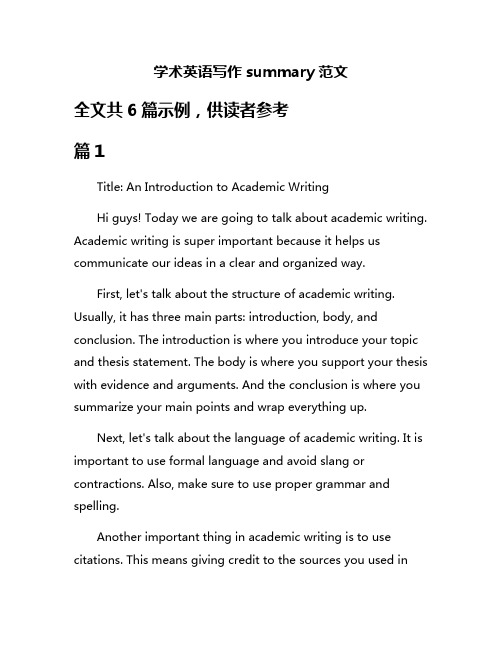
学术英语写作summary范文全文共6篇示例,供读者参考篇1Title: An Introduction to Academic WritingHi guys! Today we are going to talk about academic writing. Academic writing is super important because it helps us communicate our ideas in a clear and organized way.First, let's talk about the structure of academic writing. Usually, it has three main parts: introduction, body, and conclusion. The introduction is where you introduce your topic and thesis statement. The body is where you support your thesis with evidence and arguments. And the conclusion is where you summarize your main points and wrap everything up.Next, let's talk about the language of academic writing. It is important to use formal language and avoid slang or contractions. Also, make sure to use proper grammar and spelling.Another important thing in academic writing is to use citations. This means giving credit to the sources you used inyour writing. You can use footnotes, endnotes, or in-text citations to do this.Finally, make sure to revise and edit your writing. Check for any errors in grammar, punctuation, or spelling. It's also a good idea to have someone else read your writing to get feedback.So, that's a basic introduction to academic writing. Remember to practice and keep improving your writing skills. Happy writing!篇2Summary:In the article "The Effects of Technology on Children's Learning", the author explores the impact of technology on children's education. The author discusses how technology can enhance learning by providing access to a vast amount of information and resources. However, the author also highlights the potential negative effects of technology, such as decreased attention span and limited social interaction.The author suggests that it is important for parents and educators to strike a balance between using technology as a learning tool and encouraging traditional forms of learning. Thearticle emphasizes the importance of monitoring children's screen time and ensuring that technology is used in a way that benefits their educational development.Overall, the article acknowledges the benefits of technology in education but also emphasizes the need for caution and moderation. By being mindful of how technology is used, parents and educators can help children to harness the benefits of technology while also promoting healthy cognitive and social development.篇3Summary:Today, I want to talk about academic writing. Academic writing is like the superhero of writing because it is smart, proper, and super cool! When you write academically, you need to use big words and long sentences to show how smart you are. But don't worry, you can always use a dictionary or ask your teacher for help if you get stuck.In academic writing, you need to follow the rules. This means you have to use references and citations to give credit to the people who came up with the ideas you are talking about. This isimportant because it shows that you are honest and respectful of other people's work.Another important thing in academic writing is to stay focused on your topic. You can't just write about whatever you want – you need to stick to the main point and support it with evidence. This can be hard sometimes, but don't give up! Just keep practicing and you'll get better.So, next time you have to write an academic paper, remember to be smart, follow the rules, and stay focused. With these tips, you'll be a superhero of academic writing in no time! Good luck!篇4SummaryLast week, my teacher asked us to write a summary of an academic article for our English class. The article was about the impact of social media on teenagers' mental health. I learned a lot from reading the article, and I want to share some of the key points with you.Firstly, the article discussed how social media can have both positive and negative effects on teenagers' mental health. On theone hand, social media can help teenagers connect with friends and family, express themselves, and find support during difficult times. However, on the other hand, it can also lead to feelings of loneliness, anxiety, and low self-esteem.Secondly, the article highlighted the importance of monitoring and limiting teenagers' use of social media. Excessive use of social media has been linked to a variety of mental health issues, including depression and addiction. Parents and educators play a crucial role in helping teenagers navigate the online world and develop healthy technology habits.Lastly, the article discussed the need for more research on the long-term effects of social media on teenagers' mental health. While some studies have shown a clear link between social media use and mental health problems, more research is needed to fully understand the complex relationship between the two.In conclusion, social media has a significant impact on teenagers' mental health, and it is important for parents, educators, and policymakers to address this issue. By promoting healthy online behaviors and supporting teenagers in developing positive coping strategies, we can help prevent the negative effects of social media on mental health.篇5Oh, hello everyone! Today I want to tell you about academic writing in English. Academic writing is like writing essays or reports for school, but it's more fancy and serious. You have to use big words and make sure your sentences are clear and logical.First, you need to have a good topic. It can be anything you want to learn more about, like animals, space, or even your favorite video game. Then, you have to do research to find information and facts to support your ideas. You can use books, articles, or the internet to find the information you need.Next, you have to organize your ideas into paragraphs. Each paragraph should have a topic sentence that tells the reader what the paragraph is about. You also need to use transition words like "first," "next," and "finally" to help your reader follow along.After you write your paragraphs, you need to write a conclusion to sum up what you've learned. This is where you tell your reader why your topic is important and what you want them to remember.Finally, you have to edit and revise your writing. Make sure your sentences are clear and easy to understand. Check for spelling and grammar mistakes, and make sure you've cited your sources correctly.So, that's how you write an academic paper in English. Remember to choose a good topic, do your research, organize your ideas, write a conclusion, and edit your work. You'll be writing like a pro in no time!篇6Today I read a really cool article about academic writing and I want to share a summary with you guys. The article talks about how to write a good academic paper and gives some tips and tricks.First, the article says that you should start by choosing a topic that interests you. This will make the writing process much more fun and you'll be more motivated to do a good job.Next, the article recommends doing some research on your topic. You should read a lot of books and articles to get a good understanding of the subject. This will help you come up with some original ideas for your paper.When you start writing, the article suggests making an outline first. This will help you organize your thoughts and make sure your paper flows well.After you finish writing, it's important to edit and proofread your paper. You should check for spelling and grammar mistakes, as well as make sure your ideas are clear and easy to understand.Overall, the article emphasizes the importance of writing clearly and concisely. You should avoid using too many fancy words or complicated sentences.I think these tips are really helpful and I'm going to try them out next time I have to write a paper. I hope you guys found this summary helpful too!。
- 1、下载文档前请自行甄别文档内容的完整性,平台不提供额外的编辑、内容补充、找答案等附加服务。
- 2、"仅部分预览"的文档,不可在线预览部分如存在完整性等问题,可反馈申请退款(可完整预览的文档不适用该条件!)。
- 3、如文档侵犯您的权益,请联系客服反馈,我们会尽快为您处理(人工客服工作时间:9:00-18:30)。
academic college students professors and researchers for other people who are also academics or schorlars.It is done by specific group of people for specific purposes.Second,academic writing can be divided intocategories,including academic article conference paper,reaserach paper and poster paper .Despite they have difference,academic writing has same part, it written for specific aduiences .People in the academic write mainly to present an argument ,they ususally begin with some worthwhile and reaserch questions .Then they will attempt to answer the questions by using evidence and logical reasoning.Academic wirters also pay attention to the cohesion and coherence of their writing .Furthermore they always adoot the format of writing which is appropriate for the task at hand or expected audience .Academic writing is formal wiriting style and it not allow appear spelling punctuation and grammer errors .In a word. academic writing requires appropriate, engaging and accurate.This part is introduce the adademic writing features,the next step how can we writing academic well.we should do the following some points.we need to understand the important point is essay wirting supported by reading.we need to learn the techniques of adademic writing and learn from professional academic writers .Academic writing is a style of writing: just as ifyou write a short story or a newspaper article,there are rules to follow. Following these rulesmakes you a more credible, convincing writer.It can also help you get better marks because
your information is clearly preed on a critical judgement of complex ideas and information,rather than an appeal to emotions. Your writing should be based on things which can be seen or measured, rather than on personal beliefs.Academic language is clear and concise. You should use formal language, references andsupporting evidence to defend your argument rather than try to convince your reader using emotive language or judgemental words.
